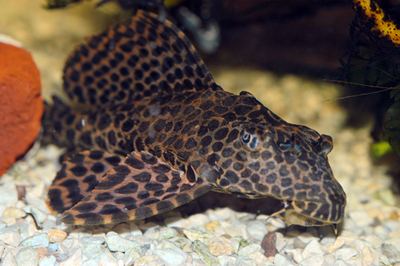Higher classification Hypostomus Rank Species | Order Catfish | |
 | ||
Similar Cory catfish, Cichlid, Catfish, Guppy, Ancistrus | ||
Pleco care info hypostomus plecostomus
Hypostomus plecostomus, the suckermouth catfish or common pleco, is a tropical fish belonging to the armored catfish family (Loricariidae), named for the armor-like longitudinal rows of scutes that cover the upper parts of the head and body (the lower surface of head and abdomen is naked). Although the name Hypostomus plecostomus is often used to refer to common plecostomus sold in aquarium shops, most are actually members of other genera.
Contents
- Pleco care info hypostomus plecostomus
- Argentina fish shipment of wild plecos tetras cichlids
- Distribution and habitat
- Diet
- In the aquarium
- Common names
- References

Suckermouth catfish are of little or no value as a food fish, although they are at least occasionally consumed over their native range. A demand exists for them, however, in the aquarium trade.
Argentina fish shipment of wild plecos tetras cichlids
Distribution and habitat
This species' native range is tropical northeastern South America; it naturally occurs in northeastern Brazil, the Guianas, and Trinidad and Tobago. Confusingly, the name Hypostomus plecostomus (or Plecostomus plecostomus) has sometimes been incorrectly used for several more-or-less similar loricariid catfishes, both in the popular and scientific literature. For example, it has sometimes been suggested that it occurs in southern Central America, but this is an entirely separate species, Hemiancistrus aspidolepis (also known under another synonym, Hypostomus panamensis).

In addition to its native range in South America, H. plecostomus has been widely introduced to several countries around the world. In the United States, it has been introduced to some regions in the South, most likely released by aquarists into the local waters. For example, they are present in a lake in the neighborhood of Hammock Trace Preserve in Melbourne, FL. In Texas, reproducing populations occur in spring-influenced habitats of the San Antonio River (Bexar County), Comal Springs (Comal County), San Marcos River (Hays County), and San Felipe Creek (Val Verde County), as well as in drainage canals in Houston.

They have also been introduced to several Asian countries. Suckermouth catfish are often cultured in ponds in Singapore and Hong Kong, where they are very popular for the aquarium trade.
Diet

Hypostomus plecostomus is named for its sucker-like mouth, which allows it to adhere to a surface, as well as to hold and rasp at food.This omnivorous species feeds on algae, aquatic plants, and small crustaceans.
In the aquarium
H. plecostomus is one of a number of species commonly referred to as "plecostomus" or "common pleco" by aquarists. These fish are sold when they are young and small, but they can grow to be a maximum size of 50 centimetres (20 in). In the aquarium, this dark-colored, bottom-feeding, nocturnal catfish is often purchased for its ability to clean algae from fish tanks.
Common names
A large variety of common names are used to describe H. plecostomus, where plecostomus and the shortened "pleco" are interchangeable in all common names. The names include:
Most of these common names are used for other species, as well, which only serves to augment the confusion surrounding H. plecostomus and other Loricariidae such as H. punctatus, Pterygoplichthys multiradiatus and P. pardalis.
